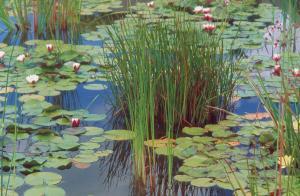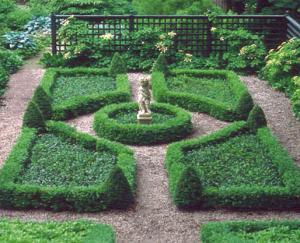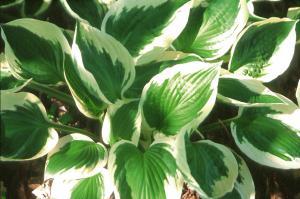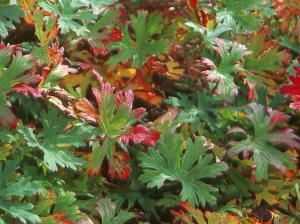By Theresa M. Forte
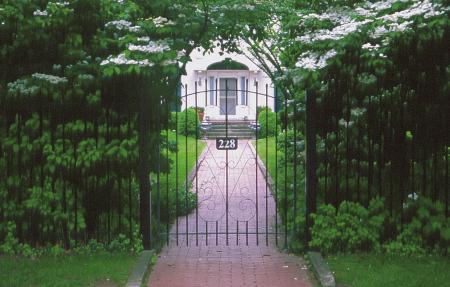 | |
| No matter what the setting, green plays a major role in providing the tranquil backdrop to some of nature's most brilliant features, whether it be water, trees, flowers, or garden ornaments. |
Green is the colour of hope. It is soft, soothing, intuitive and above all, healing. A walk in the forest can restore balance, energize and leave the visitor with a calming sense of peace and well-being. The fresh greens of spring represent regeneration. This can be translated into encouraging change, perhaps by following a new path in life.
Because it is so prevalent, green can often be taken for granted, but it is essential to the success of a garden plan. It is the balancing force in nature, intuitively connecting and supporting the prima donnas of the garden. Green is somehow neutral, allowing it to be the peacemaker between the quiet pastels and the vivacious hot shades of the spectrum.
The many (often conflicting) personalities of the word green can be found in the dictionary. Green: to plant with leaves, grass, etc.; inexperienced, naive; sickly, pale of complexion; jealous, envious; young, flourishing; vegetable food (greens) such as a salad; concerning/protecting the environment; public, grassy parkland (village green), (putting green); green belt-area of open land around a city designated for preservation; green-thumb (gardener); greenhouse and green light; the list goes on, but you can see how prevalent and complex green can be.
|
The complementary colour for green is red. Consider the common stoplight as an illustration. Red means stop, danger, do not proceed. Green, on the other hand represents safety, it is OK to proceed. In a garden, red will stop your eye, making the flower appear to move forward. Green, however, allows your eye to travel around the space, it is calming, this seems to make the garden feel more spacious. When they appear together, a deep red bloom will appear more prominent against a background of dark green foliage. (Just imagine a red rose in mid June.) Although green often represents youth and rebirth, it remains the colour of choice for many mature, sophisticated garden plans. A young garden often depends on colour for excitement and interest. In a mature garden, many clients prefer a plan that encourages an inward journey of sorts. They are no longer trying to attract attention but rather prefer a garden that is subtle, encouraging contemplation. This garden will soothe and calm them after a hectic day at the office. Green can act as a tonic, balancing the mind and body, soothing muscles and nerves, and often relieving mental stress and headaches. A predominantly green garden can become a retreat, in the spirit of a Japanese garden where the form, texture and subtle tints and hues are married into harmonious partnerships. White accents, in the form of variegated foliage, gentle flowers or painted wood details encourage the feeling of peace while giving the picture a feeling of purity and refreshment. Form and texture can better be appreciated in such a garden. The blue-grey foliage of Iris pallida variegata with each strap-like leaf edged in soft creamy white makes a striking display when planted above a bed of steel-blue Donkey-tail Spurge (Euphorbia myrsinites) in a dry, sunny bed. Alternately, frothy lime-green blooms of Lady's Mantle (Alchemilla mollis) make a beautiful, soft edging for a fieldstone pathway.
A palette of greens
Yellow/green: Alchemilla mollis (Lady's Mantle); Hosta 'Golden Tiara', H. 'June' and H. 'Sun Power'; Euphorbia polychroma (cushion spurge); Origanum 'Aureum' (Golden Oregano); Milium effusum 'Aureum' (Golden Grass); Campanula 'Dickson's Gold' (Bellflower) and Lamium maculatum 'Aureum'. Variegated foliage featuring yellow markings include: Salvia 'Icterina' (Golden Sage); Miscanthus 'Zebrinus' (Zebra Grass); Carex morrowii 'Aureovariegata' (Variegated Japanese sedge); Hakonechlioa macra 'Aureola' (Golden variegated Hakonechlioa); Hosta sieboldiana 'Frances Williams', H. 'Paul's Glory', and H. 'Great Expectations' and the dwarf H. 'Stiletto'. Variegated foliage with white markings include: Brunnera macrophylla 'Variegata' (Siberian Bugloss); Lamium maculatum 'White Nancy'; Saxifraga x urbium 'Primuloides' and Miscanthus sinensis 'Morning Light'. Blue/green foliage plants include: Festuca glauca 'Elijah Blue' (Blue Fescue); Helictotrichon sempervirens (Blue Oat Grass); Hosta 'Halcyon', H. 'Bressingham Blue'; Athyrium niponicum 'Pictum' (Japanese Painted Fern); and Panicum virgatum 'Heavy Metal' (Switch Grass). Needless to say that these coloured foliage plants are but the tip of the iceberg, new selections appear in catalogues with each passing season. A predominantly green garden will also benefit from foliage that changes in colour with the seasons. For example, perennial geraniums and oak-leaf hydrangea develop rich red overtones as the days begin to shorten. Perennial grasses gently age to a soft wheat-colour. Particularly beautiful combinations occur when the colouring of the trees and shrubs of the borders are echoed in the perennials planted at their feet. Take the time to appreciate the distinctive personalities of green as the seasons progress, it's not surprising that green is Mother Nature's favourite colour. Theresa Forte is a garden columnist, photographer and garden consultant based in Niagara Falls, Ont.. |
